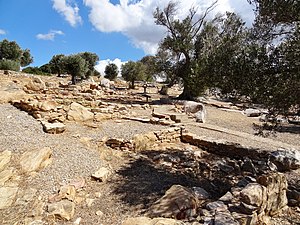Sanctuary at the springs of Flerio
Sanctuary near the sources of Flerio ( Modern Greek Ιερό στις πηγές του Φλεριού Iero stis piges tou Fleriou ), also source sanctuary at Flerio (Ιερό των Πηγών στο Φλεριό Iero ton Pigon sto Flerio ), is the name of an archaic place of worship on the Greek Cycladic island of Naxos . In which from around 800 BC A chthonic fertility goddess was worshiped in the shrine attested to in the 3rd century BC .
history
The sanctuary was built during the 8th century BC. Founded a little above the sources of Flerio. The subsurface consists of marble , which shows traces of processing by chisels . First a wall was erected in the north of the excavation site, to which a one-room, 5.4 × 6.4 meter building made of uncut and roughly cut stones with a flat roof was attached to the south, next to a large marble block. The roof was supported by two wooden pillars on curved marble bases. To the west was a terrace on which burnt offerings were made . At that time, ten meters below, in the southern area of the excavation site, there was an outbuilding with three rooms in which ritual meals were probably prepared.
Between 640 and 625 BC The west wall of the upper building was torn down and a partition wall was constructed in its place to an adjoining new building made of roughly cut marble stones. The new 4.5 × 7.6 meter building on the previous terrace had a primitive marble portal, of which the monolithic threshold has been preserved with traces of the stone door posts on the sides that stood on stone blocks. The sacred place of the terrace burnt sacrifice was now located within a stone arch in the exact center of the new building. In addition to the expansion of the not completely built-up old terrace towards the west, additional terraces were built in the south-west of the two buildings.
The walled terraces served as fire sacrifice sites. The rock is partly red from the fires. The ashes and the remains of sacrificial objects, such as bones, ceramic remains and parts of metal objects, were collected in shallow pits and covered with round slates of slate from the bedrock east of the sanctuary, sometimes with clay disks. A ceramic pot containing 94 astragaloi from goats was discovered under one of the slates . The south-western terraces initially had an entrance that was later blocked by a wall. In the south of these places of sacrifice one created, probably in the 6th century BC. BC, an entrance corridor from the west to the site of the sanctuary. After the older upper building on the east wall was damaged by movement of the adjacent marble block in the 6th century BC, It was rebuilt narrower and with a transverse wall. It now served as an auxiliary building, probably for the production of ritual meals of the later building to the west, into which a U-shaped bank was integrated.
The three-room southern outbuilding was built in the 6th century BC. Torn down and in its place a little marble temple was built to the west. The entrance to this temple was in the northeast, roughly facing the two upper buildings. The foundations consist of large, roughly cut marble stones taken from the site of the excavation site. The walls were carved, roughly rectangular blocks of marble. From the roof with its gable, numerous remains of roof tiles, also made of marble, were found. In front of the temple is the base for a small marble column in the ground, similar to the one found in the temple, on which there may have been a statue or a sphinx. Several small such sculptures were found unfinished within the sanctuary.
The spring sanctuary at Flerio was used in antiquity by workers in the neighboring marble quarries, the largest of that time on Naxos. The most common votive offerings were experimental, failed, or inadequate marble objects. In addition to the worship of a chthonic fertility goddess, attested by female clay figures as well as a large number of spindle whorls and loom weights , an inscription found nearby indicates that the twin brothers Otos and Ephialtes , giants of Greek mythology , acted as protectors of the stone breakers in the same place . Otos and Ephialtes were sons of the earth goddess Gaia . After the 6th century BC The importance of the sanctuary gradually declined.
The area was used for agriculture up to our time, as testified by olive trees , a paved threshing floor and several beehives, traditionally in lying clay jugs, northeast of the former sanctuary.
Excavations
The remains of the sanctuary's building were exposed and made accessible to visitors. The excavation site is located near Flerio (Φλεριό; other transcription : Phlerio ) about one kilometer southwest of the place Melanes (Μέλανες). The excavation site is provided with information boards throughout the site, the excavation finds are exhibited in the Museum of Melanes.
literature
- Vassilis Lambrinoudakis , Alexandra Sfyroera: Συντήρηση και ανάδειξη του αρχαίου υδραγωγείου Νάξου και τλου Ιερού των Πηγώς στινες. Ειδικός Λογαριασμός Έρευνας Πανεπιστημίου Αθηνών, Athens 2010, ISBN 978-960-466-063-6 , pp. 14-15 ( full text ).
Individual evidence
- ↑ The ancient sanctuary at Flerio. azalas.de, accessed on March 9, 2014 (based largely on the information boards at the excavation site).
Web links
- Vassilis Lambrinoudakis: Το αρχαίο Ιερό στις πηγές του Φλεριού. www.naxos.gr, accessed March 9, 2014 (Greek, English ).
- The ancient sanctuary of the springs and the quarries at Flerio (Mélanes). azalas.de, accessed on March 9, 2014 .
- Temple of the Sources. www.naxos-tours.gr, accessed on March 9, 2014 (English).
Coordinates: 37 ° 5 '6.3 " N , 25 ° 27' 4.4" E



